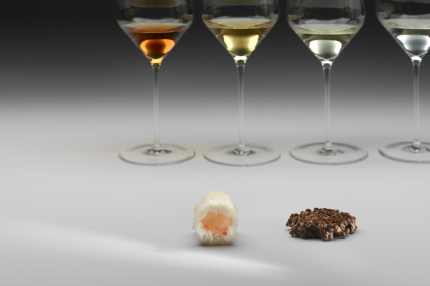SAKE AND ITS HARMONIES
By Guillermo Cruz
Although accustomed to the first impression when walking into a winery, I felt a strange sensation the first time I entered a kura (sake cellar). My mind was subconsciously looking for the shadows and humidity typical of wineries, an almost mystical world in darkness. However, in the kura, a perfect, pure, practically aseptic space opens. Sometimes, our mental imaginary and our subconscious play with our perceptions, and we find a great example of this in the world of sake.
Kuras and bodegas have little in common, but something powerful unites them: the silence in both stimulates the senses and focuses on almost imperceptible details. The silence that preaches the exceptional, the subtlety, helping to focus on that which is not evident.
More than a decade ago, Japan had already stolen the “solid” heart of some projects. Now it has also stolen our “liquid” heart with sake, a subtle way of transferring Japanese values into a bottle.
In that kura, I observed what Natsuki Kikuya had taught me about the value of the tojis (the sake brewing masters): how from every corner of the place you could feel the near-veneration for the person considered as an eminence. The toji’s passion for the living story of an ancient culture – the Japanese culture –
in its liquid state, the specific way of making sake in that family of producers.
With each sake, each producing family interprets the essence of Japan in a particular way. It is a drink that has little to do with wine and much to do with craftsmanship: because drinking sake is like drinking silk, promoting a concept of softness and of subtlety. And it does so thanks to one of the most consumed foods in the world, rice, which, thanks to different polishing and fermentation methods, opens a wide range of styles for sake.
An immense range
From doburoku, unfiltered sake consumed by the producing families themselves, to the rare koshus of ancient vintages, the range is immense. A sake menu can become a tour through the different prefectures or regions of the country. The key is rice polishing, a process that starts after drying the raw material and involves refining the grain until it reaches its heart and then cooking it. Once this process is complete, the koji transforms the rice starch into sugar. Yeasts help to ferment it, then filtering and bottling do the rest.
The families producing quality sake are seeking to shake off the stigma of the first sake to enter Europe: the low quality that many people associate with distillates rather than with fermented rice. This stigma is one of the main reasons why sake has been mired in controversy for years and why we, sommeliers, have a special responsibility of understanding and explaining sake.
They are so unique, so different from the wines we are used to, and still so unknown that a person who has never tasted them may have but one chance. If we fail in that first approach, we could close the door of curiosity to a world full of nuances and values.
Complex sake menus
In the coming years, we can expect to see sake menus as complex as great wine lists. Sake can become a means of travelling through different prefectures and, above all, interweaving sake with its history, sharing with our guests the craftsmanship behind it, the values that permeate this incredible drink with every sip. Only open-mindedness can fight against preconceptions.
The combinations between solid and liquid in the world of sake are infinite, but I also believe that it is necessary to understand its culture to see the people's heart and enjoy it fully. One of the highlights of this drink has to do with its relationship with the culture of detail. To achieve excellence in the harmonies, we must seek a shared history, a link that makes the moment unsurpassable.
There is a great diversity of styles, so the possibility of a range of pleasures becomes a reality. When working affinities and contrasts, harmony is always more straightforward with the similarities, and the risk is more significant in the differences. In the end, the best combinations are those that contain a history or a story, loaded with intangibles to seduce those living the moment, leaving an indelible mark in their thoughts.
I will propose some examples of harmonies, concocted at the Ambivium (Peñafiel, Spain) Harmony Laboratory.
From Japan to Andalusia
If there is one thing the worlds of sherry and sake have in common, it is their uniqueness, accumulated knowledge, and unsurpassed histories. With these harmonies, we attempted to reproduce classic recipes from each of the regions.
On the one hand, eggplants fried with honey, a typical dish from Sanlúcar de Barrameda, and on the other hand, a smoked eel nigiri, a specific Japanese preparation. We reversed the harmony: serving the sake with the eggplant and the sherry with the nigiri. We also wanted to introduce time into the equation: time is the most incredible luxury in life because if you have time, you have everything. If we manage to feed and drink time, we obtain an approach to the most indulgent luxury.
We chose a koshu-style Tedorigawa sake from the ‘96 vintage, aged for many years in crystal demijohn, which, in terms of aromas, has a lot to do with the oxidative aging of a sherry wine. For the sherry, we chose the Palo Cortado 'Tú no me olvides' from Bodegas Alonso: a Palo Cortado with more than 100 years in solera. Surprisingly, the harmony was unusual and worked brilliantly. The texture of the sake blended perfectly with the eggplant and the honey: it rounded out the bite. On the other hand, we gave a lot of power to the smoked eel, provoking a contrast with a lot of umami in the mouthful and sip: the solid and the liquid fought on the palate to see which was the best; although, finally, they ended up pairing together exceptionally. It was a cultural approach of two worlds at once so different, but so equal.
The following harmony is a game of textures
The intention was to combine the solid and the liquid's textures in search of an absolute affinity. We started with the caviar, as a singular entity, and put it at the same level as the inflorescences of the vineyard (those clusters that, predestined to become wine, remained in the instantaneous delight of the palate. On the other hand, with this intention of a cultural approach, we chose three styles of sake, which represent Japan's diversity. These were: junmai Dai ginjo, nama zake(unpasteurized sake) and nigori (unfiltered sake).
Three bites and three sips
The first bite was crispy bread karasatu, with caviar butter and a bunch of inflorescences. We combined it with a nama, in a game of textures that increased the risk. The second bite, marrow and caviar, was a delicious combination of sweetness combined with a junmai daiginjo. And finally, for the nigori, some fine slices of raw Kobe and inflorescences. Served in this order, we created a magical harmony where the liquid's texture and creaminess and the solid made the moment unforgettable.

